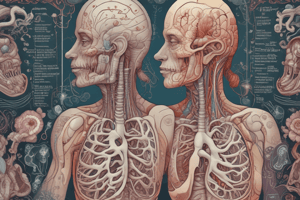Podcast
Questions and Answers
What is the percentage of basal cells in the given content?
What is the percentage of basal cells in the given content?
- 3%
- 30% (correct)
- 5%
- 25%
What is the function of brush cells?
What is the function of brush cells?
- Chemosensory receptors (correct)
- Electroreception
- Exocrine secretion
- Mechanosensory receptors
What is the surface feature of brush cells?
What is the surface feature of brush cells?
- Flagella
- Cilia
- Sterecilia
- Microvilli (correct)
What percentage of cells are brush cells?
What percentage of cells are brush cells?
Where are the afferent nerve endings of brush cells located?
Where are the afferent nerve endings of brush cells located?
What type of epithelium is found in the vestibular region?
What type of epithelium is found in the vestibular region?
What type of glands are found in the LP of the vestibular region?
What type of glands are found in the LP of the vestibular region?
What is found in the LP of the vestibular region, in addition to glands?
What is found in the LP of the vestibular region, in addition to glands?
What is the name of the region that contains sebaceous and sweat glands?
What is the name of the region that contains sebaceous and sweat glands?
What type of structure is found in the LP of the vestibular region, in addition to glands?
What type of structure is found in the LP of the vestibular region, in addition to glands?
What is the primary function of the conducting portion of the respiratory system?
What is the primary function of the conducting portion of the respiratory system?
What type of fibers are present in the conducting portion of the respiratory system?
What type of fibers are present in the conducting portion of the respiratory system?
Which of the following is NOT a component of the conducting portion of the respiratory system?
Which of the following is NOT a component of the conducting portion of the respiratory system?
What is the main function of the terminal bronchioles in the respiratory system?
What is the main function of the terminal bronchioles in the respiratory system?
What type of muscle is present in the conducting portion of the respiratory system?
What type of muscle is present in the conducting portion of the respiratory system?
What is the primary function of the epiglottis?
What is the primary function of the epiglottis?
What is the location of the epiglottis in relation to the larynx?
What is the location of the epiglottis in relation to the larynx?
What would happen if the epiglottis were not functioning correctly?
What would happen if the epiglottis were not functioning correctly?
What is the shape of the epiglottis?
What is the shape of the epiglottis?
What is the anatomical relationship between the epiglottis and the larynx?
What is the anatomical relationship between the epiglottis and the larynx?
What type of epithelium covers the lower pair, also known as the true vocal cords?
What type of epithelium covers the lower pair, also known as the true vocal cords?
What structure supports the free edge of each vocal fold?
What structure supports the free edge of each vocal fold?
What type of muscle is found in the lamina propria of the vocal folds?
What type of muscle is found in the lamina propria of the vocal folds?
How long is the trachea?
How long is the trachea?
What type of glands are found in the submucosa of the trachea?
What type of glands are found in the submucosa of the trachea?
Study Notes
Conducting Portion of Respiratory System
- Serves two main functions: providing a conduit for air travel to and from the lungs, and filtering the air
- Composed of cartilage, elastic and collagen fibers, and smooth muscle
Terminal Bronchioles and Trachea
- Terminal bronchioles have a pseudostratified columnar epithelium
- Basal cells make up 30% of cells, while brush cells (with microvilli on apical surface and afferent nerve endings on basal surface, acting as chemosensory receptors) make up 3%
Larynx
- Epithelium is pseudostratified ciliated columnar
- Vocal folds (true vocal cords) have:
- Stratified squamous epithelium
- Elastic fibers and vocal ligament supporting the free edge of each vocal fold
- Striated muscle (vocalis muscle in lamina propria)
- Important for phonation or sound production
Trachea
- Approximately 10-12 cm in length
- Composed of:
- Mucosa with respiratory epithelium and seromucous glands in lamina propria
- Submucosa with seromucous glands and 12 C-shaped rings of hyaline cartilage
Studying That Suits You
Use AI to generate personalized quizzes and flashcards to suit your learning preferences.
Description
Learn about the conducting portion of the respiratory system, its functions, and its components. Understand the role of cartilage, elastic and collagen fibers, and smooth muscle in the respiratory tract.




